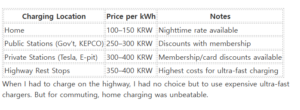Unless I was in a real rush, slow charging was clearly the better choice financially.
3. Charging Cost by Location Type
Charging costs also differ greatly depending on where you charge.
| Charging Location | Price per kWh | Notes |
|---|---|---|
| Home | 100–150 KRW | Nighttime rate available |
| Public Stations (Gov’t, KEPCO) | 250–300 KRW | Discounts with membership |
| Private Stations (Tesla, E-pit) | 300–400 KRW | Membership/card discounts available |
| Highway Rest Stops | 350–400 KRW | Highest costs for ultra-fast charging |
When I had to charge on the highway, I had no choice but to use expensive ultra-fast chargers. But for commuting, home charging was unbeatable.

4. Money-Saving Charging Tips
There was a time when my charging bill was way too high, so I tried various ways to cut costs. Here’s what worked best for me:
✅ Use home charging – You can save up to 50% with off-peak electricity rates
✅ Use fast charging only when necessary – Preferably when battery is under 20%
✅ Use EV charging cards – The Ministry of Environment card offers 10–20% off
✅ Find free charging stations – Some marts and department stores offer free charging in their parking lots
Those free stations were a gem! If you can time it right, you can charge your car completely for free at large retailers or government buildings.
5. EV Charging Card Discounts
If you want to save on charging after getting an EV, a dedicated EV charging card is a must.
| Card Issuer | Main Benefit | Discount Rate |
|---|---|---|
| Ministry of Environment | Public station discounts | ~10–20% |
| Hyundai Blue Members | Hyundai-exclusive station discounts | ~10% |
| SK E-Mobility | SK station discounts | ~5–15% |
| Samsung/KB EV Card | Discounts at multiple station types | ~5–10% |
I mostly used the Ministry of Environment card. Since it works at public stations nationwide, it really helped reduce my overall costs.
6. Regional Charging Cost Comparison
Here’s what I noticed from my own experience in different regions:
-
Seoul & Capital Area: Many public chargers, relatively cheaper rates
-
Rural Areas: Fewer chargers, mostly fast chargers which cost more
-
Highway Rest Stops: Lots of ultra-fast chargers, highest rates overall
In rural areas especially, I often had to rely on expensive fast charging due to the lack of available stations.
7. Future Outlook for EV Charging Costs
As more people drive EVs, charging fees are constantly changing.
-
The government is working to limit increases in charging rates
-
As more private charging companies appear, price competition may increase
-
We may also see discount programs linked to renewable energy sources like solar and wind
It’s important to keep an eye on how EV charging costs evolve in the future.
How Do You Charge Your EV?
If you have any great tips for saving on charging, feel free to share them in the comments! 💡
In Conclusion
EV charging costs vary significantly depending on the charging method, location, and region. For me, a combination of home charging, occasional fast charging, and using discount cards turned out to be the most cost-effective.
Find the charging strategy that works best for you, and make the most of your EV smartly!